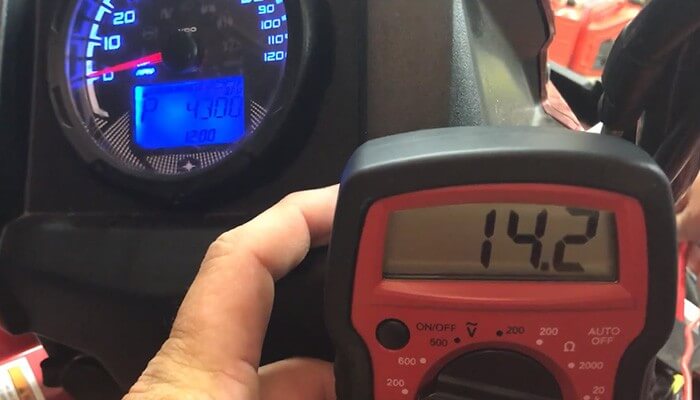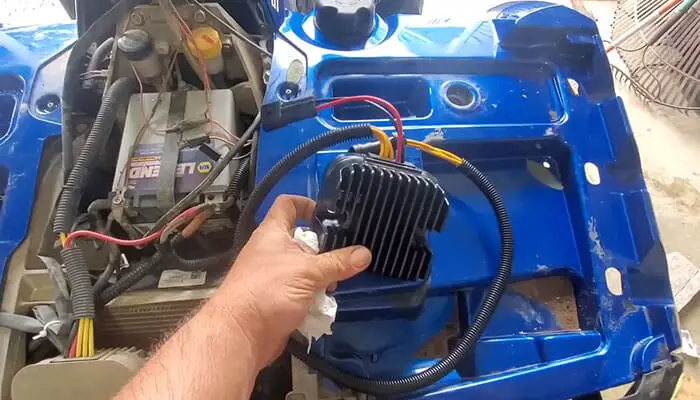Polaris Sportsman Voltage Regulator Test: [6 Steps]
If your Polaris sportsman is a popular brand among ATV owners. However, they often encounter dead batteries due to unstable voltage surges. We understand if you’re concerned about it too and wondering how to keep it in check.
So, how to conduct a Polaris sportsman voltage regulator test?
You can do it in 5 easy steps. First, you need to connect the clamps on a multimeter to the terminals of your battery. Then, you’ve to take the first reading. After that, turn the engines on to take the second reading. Now, rev the engines with the accelerator and take the final reading. That’s it!
You might be wondering that’s all you need to know. But, to do it perfectly, you need to dive deeper. We will guide you through all these steps right here in this article.
So, sit tight and read along!
Step-By-Step Guideline [6 Easy Steps!]

Here, we’ve assembled this 6-step guideline to walk you through the Polaris sportsman voltage regulator test. Following these easy steps will help you conduct this whole testing like a piece of cake. You can use this guideline for your Polaris sportsman 850 voltage regulator test too!
So, let’s dive right in, shall we?
Step 1 of 6: Connect the Multimeter
For starters, you will need a multimeter to carry out this whole testing. This is the most important equipment needed for this.
The multimeter is essential equipment used to measure various electrical properties. It can typically measure voltage, resistance, and so on.
Multimeters are comparatively cheap in terms of diagnostic tools. It will cost you somewhere around $14 to $100. Here we are mentioning some quality multimeters for you to get for this test:
- KAIWEETS Digital Multimeter
- AstroAI Digital Multimeter
Hopefully, you’ll find this suggestion useful!
Now, set the multimeter to the voltage by using the dial or button on it. Read the manual if you need to find the dial. Always remember to change it to voltage, otherwise, it could permanently damage your Polaris.
if you look closely, you’ll find two clamps on your multimeter. They are attached to two cords, one of which is black and the other one red. You will need to connect these two clamps to the terminals of your battery.
You will find two nodes on the battery with + and – signs on them. Connect the black clamp to the + node and the red clamp to the – node. The first step is done!
However, there might be a plastic cap covering your battery. Get rid of it to find the nodes.
Step 2 of 6: Take The 1st Reading
Now is the time to take your 1st reading from the multimeter. The readings will show up on the screen of the multimeter.
The standard reading here is 12 volts with the Polaris turned off.
If the reading is a bit over 12 volts, your battery is doing good. However, if it’s below 12 volts, your battery needs to be replaced since it’s getting weaker.
You could face a rather unusual situation where there is no reading. It could potentially mean that your battery is dead. Or it could mean that the multimeter isn’t attached properly to the battery.
Take the reading and note it down.
Step 3 of 6: Turn The Engine On
For the next step, you need to turn the engine on. Start the engine by turning the ignition key on.
Make sure that your Polaris Sportsman is on Parking or “P” in the gear shifter. It will prevent the vehicle from moving when you are conducting the test. Also, the parking brakes should be engaged for further safety.
If your ATV has an ignition switch or button, you have to use it instead of a key. You’ll need to use a key for your Polaris sportsman 570 voltage regulator test!
Step 4 of 6: Take The 2nd Reading
Now, it’s time for you to take the 2nd reading. The process is similar to the 2nd step.
Look at the screen of your multimeter and take the reading.
With the engine on, there should be an increase in the reading. It should be around 13.8 volts with the engine on but in parking or idle. If it is, then the alternator is doing a good job in charging the battery.
However, if the reading is less than 13.8 volts, it means that your battery is dying and needs replacement. If it is well over 13.8 volts, it means that you have a faulty voltage regulator.
Note down the 2nd reading as well.
Step 5 of 6: Rev The Polaris’s Engine
For the 5th step, you’ll have to step on the gas!
Find someone to assist you while you conduct the testing. Ask your friend or family member for it. Do not involve someone underaged for this task since they could press the wrong buttons.
Ask the other person to slowly rev the engine by stepping on the gas. Instruct him/her to slowly take it up to 1500-2000 RPMs. While they do it, you keep looking at the multimeter.
Step 6 of 6: Take The 3rd Reading
While the other person steps on the gas and revs the engine, take the 3rd reading. Follow the same process to take the reading from the multimeter.
The voltage regulator is designed to cap the volt at about 14.5 volts. So, if the reading exceeds 14.5 volts, you might have a voltage regulator that’s faulty. This means that your Polaris Sportsman is at risk and you need a new regulator immediately!
However, if the reading is still below 13.8 volts, your battery is slowly dying. There is no fix to it other than replacing it immediately.
By following these steps, you can conduct a Polaris Sportsman voltage regulator test on your own! The process is similar to the 2000 Polaris sportsman voltage regulator test!
What Happens If You Have a Faulty Voltage Regulator?

Having a faulty voltage regulator puts your Polaris Sportsman at grave risk. It could potentially cause components to not function properly that require minimum voltage. These components could include the ignition system or the fuel pump of your ATV.
You may also encounter a sputtering engine or a rough idle state. Or, you may simply find insufficient acceleration when you press on the gas.
Bottom line is that a faulty voltage regulator will cause you a heavy price to pay. Be it for your 2000 Polaris sportsman 500 voltage regulator test!
If it takes out other components as well, the pile of repair expenses just keeps rising. Hence, it’s important that you conduct this test at the first sign of a faulty regulator.
FAQs
What are the symptoms of a faulty voltage regulator?
There are several symptoms indicating a bad voltage regulator in your ATV. You may find your ATV going overboard with power. Your ATV might not provide enough power for acceleration. You could encounter dim or flickering lights on your Polaris. Or you might experience a dead battery all of a sudden.
How do voltage regulators go bad?
There’re various common reasons that cause the voltage regulator to break down. It could be due to leaving the lights turned on. A faulty alternator could also cause the regulator to go bad. Or, in most cases, the battery gets too old and fails to provide enough power. The only solution is a replacement.
Can your battery be drained by a faulty voltage regulator?
Yes, your ATV’s battery can definitely get drained by a faulty voltage regulator. It could be one of the reasons why your battery is even dead. When a voltage regulator is damaged, the battery doesn’t charge anymore. Consequently, your battery will die soon due to a lack of charging eventually.
Final Words
Having a faulty voltage regulator in your Polaris Sportsman can be a real pain. Hopefully, now you will be able to conduct the Polaris sportsman voltage regulator test by yourself!
Always make sure that you’ve set the multimeter to voltage and not ohm.
We will see you in some other article very soon. Till then, adios Polaris Heads!
- Honda Pioneer 1000 5 Vs Polaris General 4: Epic Showdown - July 12, 2024
- Polaris Voodoo Blue Vs Velocity Blue: Epic Duel! - July 12, 2024
- Polaris Engine Knock at Idle: Troubleshooting Tips - July 12, 2024

